So you think you’re kinky, huh?
By now you may have read our “5 Things Kinky Swingers Enjoy” blog and realized you’re ‘Swinky’. Maybe you’re not, but at least curious and wonder what the next step is.
In the BDSM lifestyle, the adage “knowledge is power” rings true. Knowing what to expect, or what you are embarking on will make your experience both safer, and more pleasurable. Who doesn’t want to experience as much pleasure (and pain) as you can handle?
Below are common terms you will hear used in the kink lifestyle, and basic guidelines that you should respect and observe when venturing into a dungeon. I’ve also included some photos and explanations of various toys and furniture you may find in your basic dungeon space.
Cruise Dungeon 101 – Kinky Terms:
BDSM – Bondage/Discipline, Dominance/Submission, Sadism/Masochism: a combined acronym often used as a catchall for anything in the kink scene.
Scene – A time period when a couple partakes in BDSM activities. Also used to refer to the BDSM community (“the Scene”).
Top – Person “doing the action”. Not to be confused with Dominant (aka Dom/Domme) which is the person who “puts the scene together”. For example, a Top could be tying up the Domme because she wants to be suspended.
Bottom – one who receives physical sensation from a top in a scene; the one-done-to rather than the doer.
Dom/Domme – A bit of lingo to refer to the dominant person. The person who exercises control. Domme refers to a woman who exercises control (see also Dominatrix)
Submissive – “Sub” for short. A person that gives up control either all the time or for a specified period.
Switch – Someone who likes being both top and bottom, either in one scene or on different occasions.
Drop – A feeling of deflation or slight depression that comes after a kinky scene, party, convention, or conference. Usually caused by the removal of positive stimuli and the endorphins they produce either from play or being surrounded by others within the kinky community.
Aftercare – The time after a BDSM scene or play session in which the participants calm down, discuss the previous events and their personal reactions to them, and slowly come back in touch with reality. BDSM often involves an endorphin high and very intense experience, and failure to engage in proper aftercare can lead to drop as these return to more everyday levels. In some BDSM relationships, such as D/s, aftercare may involve the Dominant caring for the submissive if physical pain was inflicted
Subspace – A “natural high” that a sub (or bottom) gets during a scene or when being controlled. The sub may feel disconnected from time, space, and/or their body, and may have limited ability to communicate. It is critical that a Dom(me)/Top take responsibility for the sub/bottom and be aware of their well being if they are in subspace.
Bondage – Acts involving the physical restraint of a partner. Bondage typically refers to total restraint, however, it can be limited to a particular body part, such as breast bondage.
Consent – The Mutual agreement to the terms of a scene or ongoing BDSM relationship.
Collared – Submissive or slave who is owned, usually (but certainly not exclusively) in a loving intimate relationship with a Dom/Domme. It is common etiquette to not touch or ask a sub/slave to remove their collar without consent from the Dom/Domme first.
Safeword – A codeword a bottom can use to have BDSM activity stopped or slowed immediately. ‘Red’ is the universal safeword, but others may be pre-determined before a scene. ‘Yellow’ is the universal for slow down.
DM – Stands for ‘Dungeon Monitor’, a person who supervises the interactions between participants at a play party or dungeons to enforce house rules – essentially, the bouncer of a BDSM event.
Hard Limit – What someone absolutely will not do; non-negotiable.
Soft Limit – Something that someone is hesitant to do or nervous to try. They can sometimes be talked into the activity, or preferably it may be negotiated at a trial or beginner level into a scene.
There are still so many more terms out there in this scene. For a more comprehensive list, feel free to check out this [Wikipedia Page here]
Cruise Dungeon 101 – Kink Guidelines
Just like the swinging lifestyle, BDSM has an unspoken set of etiquette rules and respect that come along with taking part in these activities. This is a list of some of those basic ideas. When in doubt, never be afraid to ask.
The Stoplight Rule: In the section above, we discussed the term ‘safeword’. This is a word that puts a halt to all play and lets the Top/Dominant know that the Bottom/Sub have reached their limit.
The universal, most commonly used safe words are ‘Red, Yellow, and Green’ (just like a stoplight).
Red will mean stop immediately. Yellow is a warning to ease up or change the type of play. Green means all is well.
Every couple may come up with their own set of words unique to them, these should be discussed before entering a scene or D/s relationship.
Negotiating a scene: There are many forms of play. Playful and fun, heavy and serious, as well as those that may seem a bit extreme for you. One thing to realize is that every scene has been discussed before the play even begins. All players in the scene are aware of the type of actions that are happening or will happen. It is very important that you go over what is permitted, what is forbidden (see hard limits and soft limits), and to both agree on safewords.
Respect the scene space: As couples play they can get so hyper-focused on the scene, they may not want to be disturbed. Never interrupt any scene, no matter what. This is both for your safety as well as the Top and Bottom. If you think it may be getting too unsafe, find a DM. Aside from those in the scene, they are the only ones permitted to determine if and when a scene should be stopped.
NEWBIE TIP: If you feel that you have the right to lean in to whisper things to the bottom or to touch them, you don’t.
You may only enter a scene if it has been pre-negotiated by the players and yourself. Keeping the unnecessary talking to a minimum and at a low volume is also respectful to not breaking the focus of those playing. Otherwise, the best thing to do is to stand back, casually watch, be quiet and enjoy.
Watch out for the backswing: This is similar in respect to the ‘Respect The Space’ rule. When playing in a scene, a Top may be using toys of different types. (See below for examples). Some toys will have a backswing.
NEWBIE TIP: Much like you wouldn’t want to walk through someone’s space while they swing a golf club or baseball bat, don’t walk through the area where someone is swinging a whip or flogger.
Not only will you risk injuring yourself but it also takes the Top out of the concentration he or she has on the scene.
Clean up: It’s very likely you or your sub has sweat (or cried, maybe even bled) and for safety, it is necessary to wipe down your area. Just like after playtime in the playroom, it is proper etiquette to clean up after you’ve played to prevent disease or germs from spreading. Wipe down any equipment you used (toys or furniture) with Lysol wipes. The dungeon space should and usually has a station with these cleaning items or something similar.
Consent, consent, consent: In my time in both lifestyles and talking to kink players, I’ve heard the same issue brought up time and time again. It is a common misconception that swingers would rather ‘ask for forgiveness over permission’. This drives the kinksters crazy because they are the opposite.
NEWBIE TIP: In BDSM, you ask for consent before doing anything. Even as much as touching someone in a flirty way.
Due to the intensity of the subject matter (the scenes they take part in), they believe in personal space and permission to prevent any miscommunications that could lead to conflict or issues between partners, etc.
This is just a short list of common etiquette and rules when in a dungeon space. If you have any other questions, find a DM. They will have the answers to all of your questions or can point you in the right direction.
Cruise Dungeon 101 – Dungeon Furniture & Toys:
Toys and furniture in the BDSM scene are aides to increase the play session you have with your partner. Every item has its own specific perks and qualities. When it comes to toys, they can produce different types of sensations, from ‘stingy’ like a slap which can produce welts, to ‘thuddy’ like a punch which can produce more bruising.
St. Andrew’s Cross: A common piece of equipment in BDSM dungeons. Shaped like a large X, it typically provides restraining points for ankles, wrists, and also the waist. When secured to a cross, the subject is restrained in a spreadeagle position. They can be faced towards the cross with their back and butt exposed, or facing forwards with their chest and genitals exposed. In my experience, a bottom can suffer from tingling or numbness in their hands and arms from being restrained in this position for an extended amount of time. That is why I always check in verbally to make sure my partner still has feeling in those areas, or by giving them a light squeeze to check for sensation from the bottom.

Spanking Bench: A piece of furniture used to position a bottom on, with or without restraints. They come in many sizes and styles, the most popular of which is similar to a sawhorse with a padded top and rings for restraints if desired.
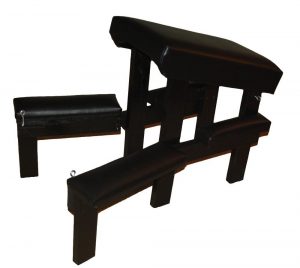
Suspension Rig: A large wooden or metal frame built to support the body weight of one to multiple individuals being suspended in the air by rope or other material. A typical rig will have rings or eyeholes meant to be suspension points to tie the rope to.
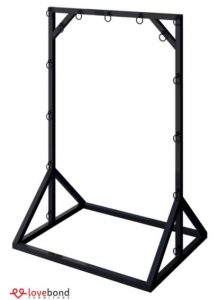
Paddles: A spanking paddle is an implement used to strike a person on the buttocks. Flat and rigid on the striking end. A ping-pong paddle is a common example. Varieties of this toy may be made of wood, plastic, and could also have leather covering. Most paddles create a ‘stingy’ sensation when struck, similar to a slap/spank.
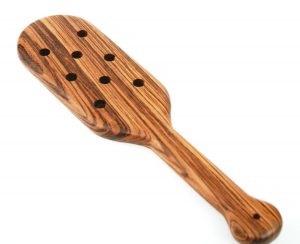
Whips/Crops/Floggers: A Whip is pretty self-explanatory. Think Indiana Jones. Only those with extreme expertise should wield this toy as it has the potential to do severe damage to you or your partner.
A whip produces a highly “stingy” type of pain, and can/will break the skin. A crop will have a fairly stiff stock, and is only 2-2.5 feet in length, with a “popper” – a looped flap of leather – at the end. This can produce a ‘stingy’ sensation.
A flogger, on the other hand, is a whip with many strands, specialized mostly for the buttock area or the breast. The strands can be made of different materials that produce different sensations from “stingy” to a “thuddy” feeling of pain. This can also vary depending on the severity by which the flogger is swung. A light caress or a hard swing will increase or decrease the pain.
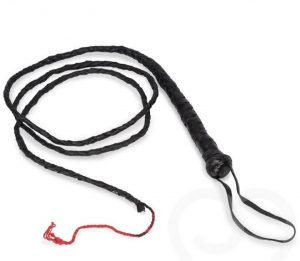
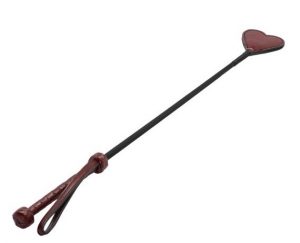
Rope: Just like many of the other toys in BDSM, rope comes in a variety of material for a multitude of purposes. From hemp and coconut, which is better for suspension, to silk and nylon which can be colored and more for body harnesses and a styled look. If you are looking into learning rope, some things to read up on besides knots are pressure points in the body, know the proper knots to tie to prevent cutting off circulation and how to correctly tie someone up and bring them down safely.
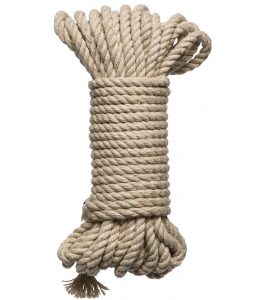
Blindfolds: Blindfolds are simple, effective and erotic. The imagination of the blindfolded partner runs wild as his or her partner performs BDSM related activities on him or her. A blindfold is an ideal way for a shy partner to lose his or her sexual inhibitions. Your partner will soon embrace the passions within him or her as the sensual nature of BDSM take over their body. Taking away one sense can and has been known to heighten other senses.
NEWBIE TIP: Imagine being blindfolded, not know where or when your partner(s) will kiss your skin, lightly brush your exposed body or cause that jump of pain on an exposed butt.
Restraints: The most common restraints are handcuffs. Who reading this has never owned or thought of owning a pair of fuzzy cuffs? Other items used for restaining can be rope, neckties, or actual restraints meant for just this purpose. Just like blindfolds, taking away a partner’s ability to move or get away can serve to heighten the reality. Of course, along with the pleasure comes the responsibility. Safewords are extremely important for scenes involving restraining or taking the control away from anyone.

BDSM can be not only fun but extremely erotic when done correctly and safely. I have been in the BDSM lifestyle for 10 years, and to this day there are still things I am learning about. Ways to improve, or be safer on top of the new and fun ways I learn to bring pleasure and pain to my partner in a consensual and interesting way. If you have any desire to get into any of the activities I’ve listed above find someone who has some prowess in that field and never be afraid to ask questions.
Happy Spanking and Sinning!


